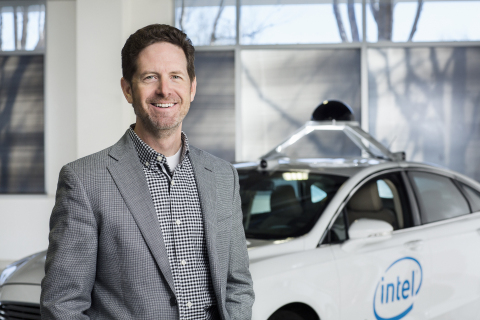Putting Self-Driving Cars on the Road Will Be My Biggest Accomplishment
SANTA CLARA, Calif. — (BUSINESS WIRE) — May 3, 2017 — The following is an opinion editorial provided by Doug Davis, senior vice president and general manager of the Automated Driving Group (ADG) at Intel Corporation:
This Smart News Release features multimedia. View the full release here: http://www.businesswire.com/news/home/20170503005982/en/

Intel’s Doug Davis, senior vice president and general manager of the Automated Driving Group (ADG) at Intel Corporation, speaks to investors and media about Intel’s role in the autonomous vehicle market as part of Intel’s Investors Day events at the 2016 Intel Developer Forum in San Francisco on Thursday, Aug. 18, 2016. (Credit: Intel Corporation)
For more than 30 years, I have climbed out of bed to go work at Intel. But never in those 30 years have I been more excited to do so than I am right now leading Intel’s autonomous vehicle team.
Don’t get me wrong – I’ve had an absolutely wonderful career and have worked on some programs that have had a significant impact on the world around us. But the chance to solve one of the most complex technology challenges of our time, the opportunity to help the auto industry reinvent transportation, the potential to save a million lives every year – those things are unlike anything I’ve done before. They’re the reason I postponed my retirement.
Press Kits: 2017 Autonomous Driving Workshop | Autonomous Driving at Intel
I have unwavering confidence that Intel will succeed in autonomous driving. We have an astounding breadth and depth of experience and the world’s finest technology toolkit to apply to this challenge. We have tapped resources from across the company and have added experienced talent from the automotive industry. Our teams are operating in high gear and will deliver the necessary technology breakthroughs. Here’s why:
First: We are already demonstrating great progress
Intel technology is in hundreds of autonomous test vehicles on the roads today. Not all carmakers are talking about who is powering the brains in their test cars lest they give away secrets. But the fact is many of them are using Intel. I encourage you to open their trunks, boots or hatchbacks and see which tech company they are relying on the most to provide the brains for their development vehicles.
Today we are also showing off one of the first of approximately 40 highly automated driving (HAD) cars promised from BMW, Intel and Mobileye this year. It was less than a year ago that the three companies announced plans to bring highly and fully autonomous vehicles into series production by 2021 through the development of a common platform. We are now successfully demonstrating that platform and are preparing plans to bring it to market for other OEMs and tier-one suppliers to accelerate their programs. Stay tuned for more on that front.
Second: We are prepared for the data challenge
The single most important factor in autonomous driving is data – how best to process it, manage it, move it, store it, share it and learn from it. From PCs to data centers and everywhere in between, no company’s silicon has analyzed, computed and moved more data than Intel’s. As we move down the road toward autonomous cars, the data challenge will become much more complex and require new ways to work with data inside the vehicle, throughout the network and across the cloud.
To ensure we have the absolute right strategy to handle that data challenge, we’ve installed the first of several planned data centers dedicated to autonomous driving. These unique labs will be used for algorithm development and training, as well as for understanding the special infrastructure needs for autonomous driving data movement and storage. Researchers will continually feed information from Intel’s test cars into these data centers to train neural networks and improve machine learning algorithms. And, we’re busy building similar labs with customers and partners.
Which brings me to artificial intelligence (AI). Mastering AI both inside the car and in the data center will be essential to the autonomous driving data challenge. Here it’s important to remember that autonomous driving isn’t a game. When cars are thinking and acting without human intervention, they must be able to do so in a safe and trustworthy way. The artificial intelligence needed to make this happen isn’t just computer vision – think voice, decision-making, personalization and preferences. Each of those AI workloads needs a different set of algorithms and likely different kind of processing for optimum performance. If all we needed was a supercomputer to handle the autonomous driving data challenge, our work would be done.
Third: We’ve built big industries before and will do it again
I’ve said this before: Autonomous driving will accelerate when the
industry comes together to align on common platforms and technologies.
That enables developers to go quickly and in volume while still
differentiating their solutions in software.








